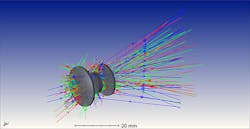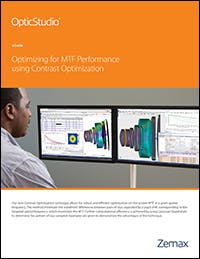The importance of Modulation Transfer Function in optical design
Modulation Transfer Function (MTF) is one of the most important parameters by which image quality is measured and the performance of an optical system is characterized. MTF optimization is especially useful for extended images that have cutoff frequencies set by the detector pixel size, because lower spatial frequencies can be improved at the expense of higher, unneeded frequencies. Optical systems with MTF specifications include products like cell phone cameras or digital microscopes.
Spatial frequency defined
Spatial frequency is critical to all types of imaging, from photography to medical imaging. If you’ve seen a printer do a line-pair resolution test, that’s testing for spatial frequency. The number of line pairs per millimeter is the spatial frequency: the number of cycles per degree of visual angle. Images with high spatial frequency show finer detail and those with low spatial frequency show less detail. MTF describes the contrast of a spatial frequency in a scene.
Optimizing for the best MFT
Until now, the only way to optimize for the best MTF was to optimize directly on the MTF value, but this is computationally expensive, slow, and difficult to do—and it often fails.
To overcome these problems, Zemax developed an optimization theory called Contrast Optimization, which uses the Moore-Elliott method to target the best MTF response up to a desired spatial frequency. This method adds a new criterion, called Contrast, in the Optimization Wizard in OpticStudio. Building a Contrast merit function populates the software’s Merit Function Editor with MECS, MECT, MECA, MECX, and MECN operands. Contrast Optimization significantly reduces the amount of time it takes to design optical products with MTF specifications.
Benefits of the award-winning OpticStudio Contrast Optimization feature include:
- Targets all frequencies: It targets all up to a certain cut-off frequency instead of one frequency for MTF operand only
- Faster calculations: It’s much faster than calculating MTF directly—as fast as wavefront optimization
- Reliability: The theory works even when MTF behaves badly due to highly aberrated starting points
eGuide: Optimizing for MTF Performance using Contrast Optimization
Learn how the Contrast Optimization feature in OpticStudio simplifies the optimization parameter space to find the best possible design more quickly.


